From scissors, PFAS everywhere to effects of standardized tests, incarcerated moms
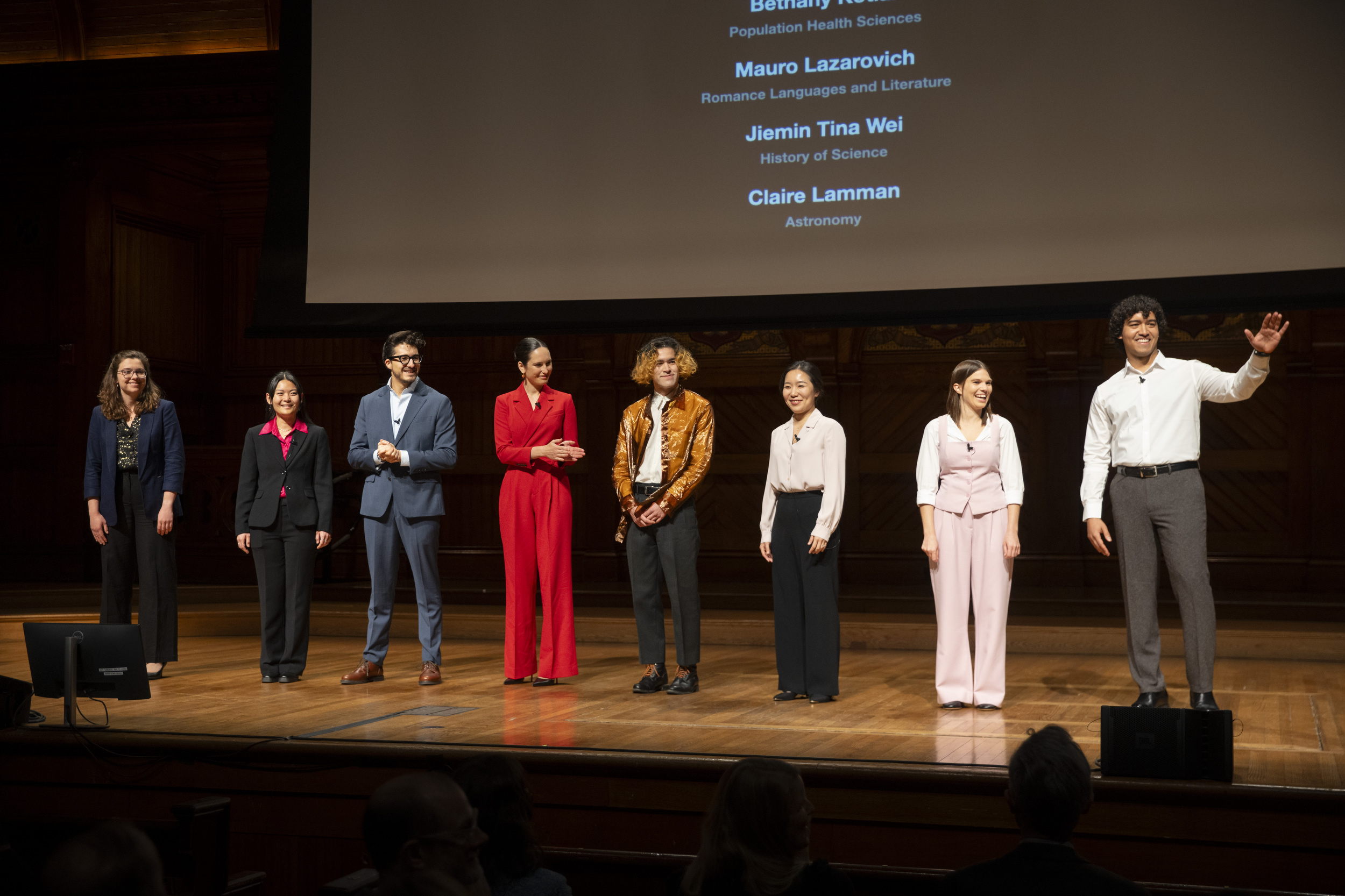
Harvard Horizon Scholars Claire Lamman (from left), Jiemin Tina Wei, Mauro Lazarovich, Bethany Kotlar, Noah Toyonaga, Juhee Kang, Heidi Pickard, and Dylan Renaud.
Photos by Niles Singer/Harvard Staff Photographer
Harvard Horizons Symposium highlights stunning, impactful research of grad students
The audience at Sanders Theatre whooped and cheered last Tuesday night. “Let the Harvard Horizons 2024 Symposium begin!” boomed Emma Dench, dean of the Harvard Kenneth C. Griffin Graduate School of Arts and Sciences. Each year, a GSAS committee picks eight Ph.D. students to participate in Harvard Horizons, an initiative to recognize and celebrate the work of promising scholars. The selected grad students get the opportunity to present their work at the symposium and prepare through personalized coaching sessions with faculty mentors and the Derek Bok Center for Teaching and Learning.
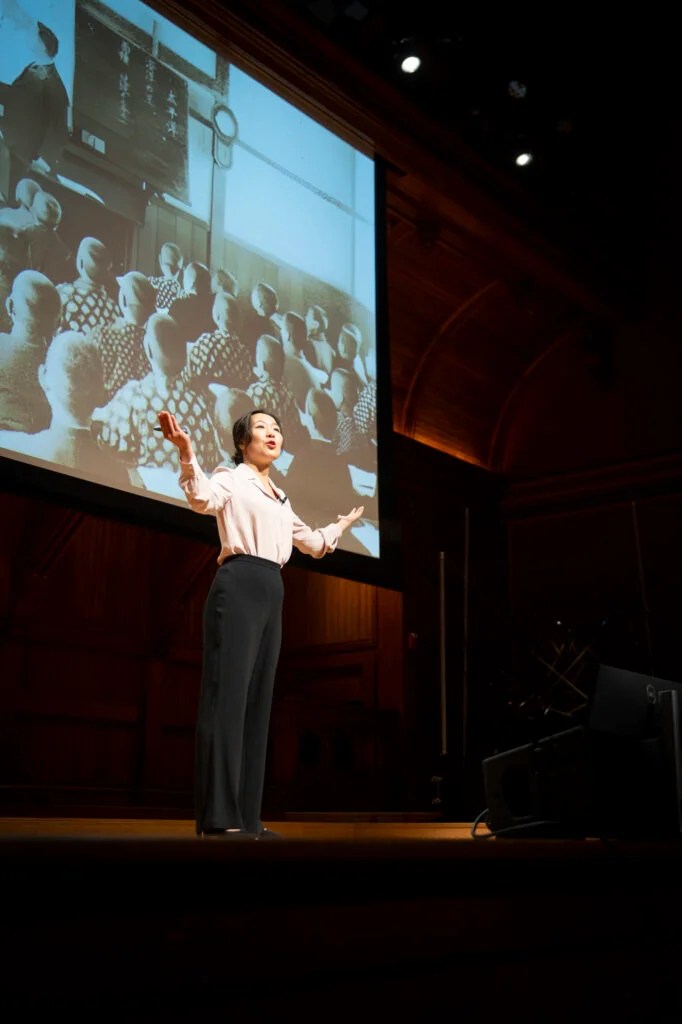
Juhee Kang
History and East Asian Languages and Civilizations
As Japan was modernizing its education system in the early 20th century, the nation faced a problem: how to distribute resources in a fair and efficient way? The Ministry of Education turned to standardized testing. In her talk, Kang traced the evolution of the practice, showing how officials attempted to measure and categorize intellect and personality traits. While some of these methods delivered chuckles from the audience, Kang emphasized that studying these early tests is helpful in tracing the evolution of the measurement of human intelligence. “All tests are experiments, and even when experiments fail, we learn something for the better,” she said.
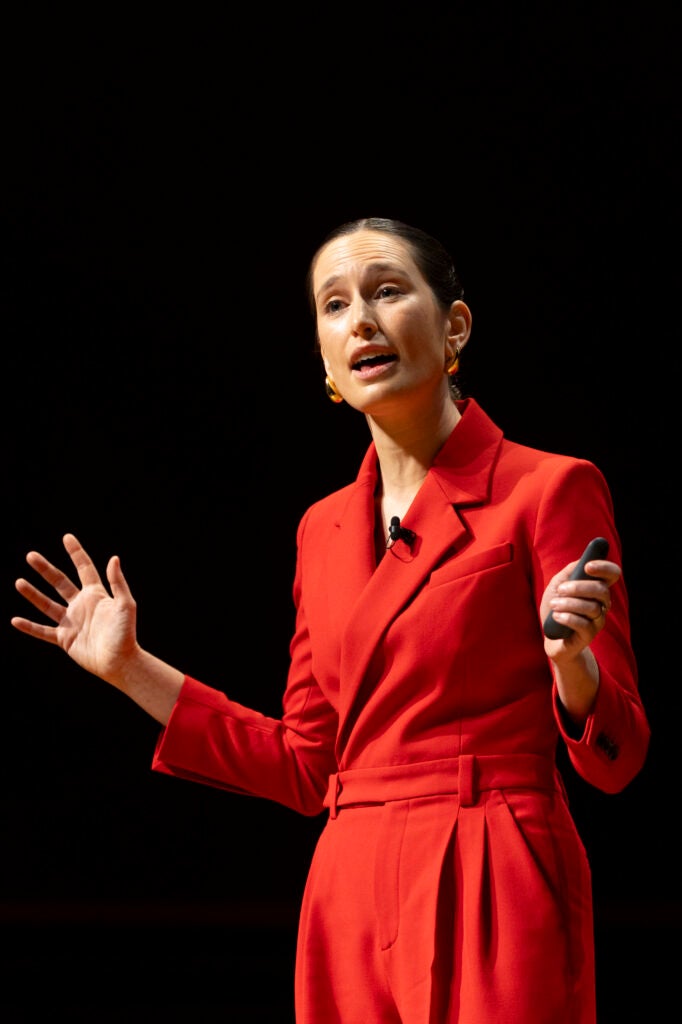
Harvard University
Bethany Kotlar
Population Health Sciences
Kotlar has already changed the lives of hundreds of incarcerated women and their children through her nonprofit Motherhood Beyond Bars, which provides education and support for that community. Her work began in one of Georgia’s largest prisons, as she sat and listened to women who were imprisoned while pregnant. “Their stories changed my career,” she told the audience. In the U.S., prison is the only institutional structure in which women and their newborns are routinely separated, mere hours after birth. The effects of this and of the incarceration of expectant mothers on in utero development have only just begun to be studied. Her work is uncovering the serious consequences incarceration has on this critical time in early childhood development. “It’s time to stop punishing these babies in utero. These children deserve better,” she said.
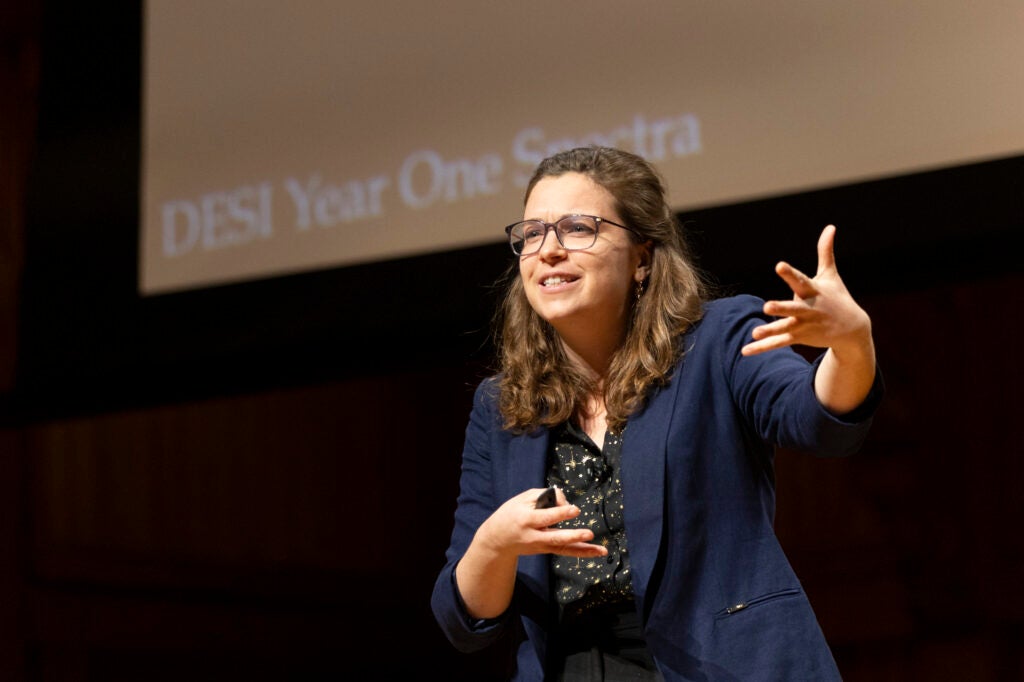
Harvard University
Claire Lamman
Astronomy
“In dark skies, you can see an uncountable number of stars. But deep in the darkness behind them lie an even greater number of galaxies,” Lamman began her talk. She is participating in a global project to create a map of galaxies. The way the celestial systems interact with each other in space is like a tangled, complex web. She acknowledges that their work is big, at “scales well beyond our daily experience.” And yet it’s important work that addresses fundamental human questions: What does the universe look like? How does it change? And why?

Harvard University
Mauro Lazarovich
Romance Languages & Literatures
Lazarovich began his talk by reciting “La Huella,” a poem by the Chilean poet Gabriela Mistral written in 1939. He used this poem to talk about how poetry and art have been used for decades to address human refugee crises throughout time. Mistral, the pen name of diplomat and educator Lucila Godoy Alcayaga, became the first Latin American author to receive the Nobel Prize in literature. She witnessed the plight of these stateless people in her role as a consul. And while she couldn’t question diplomatic policy in that role, she could do so as a poet, Lazarovich said. He cited her work as an example of how writers and artists grapple with the challenge of using their voices to advocate for the rights of others. “Their works confront us readers with these realities, compelling us to articulate our own ethical responsibilities,” Lazarovich said.

Heidi Pickard
Engineering Sciences
Pickard joked that she is what one might call a “chemical detective,” investigating the presence of PFAS, also known as forever chemicals, in the water we drink and food we consume. PFAS, which have been linked to certain cancers and endocrine problems, are used in a shockingly wide array of consumer products and packaging. Tens of thousands of PFAS now exist, leading to global contamination in our environment — and our bodies. “PFAS is in the blood of every single one of us in this room,” she told the audience. Despite the danger, there is little oversight or regulation. What’s more, only a few well-known PFAS can be detected and measured. She’s trying to close that gap and raise awareness of why this issue is critical. In closing, she said, “Together, we can combat this invisible threat and reduce our exposure to these harmful chemicals.”
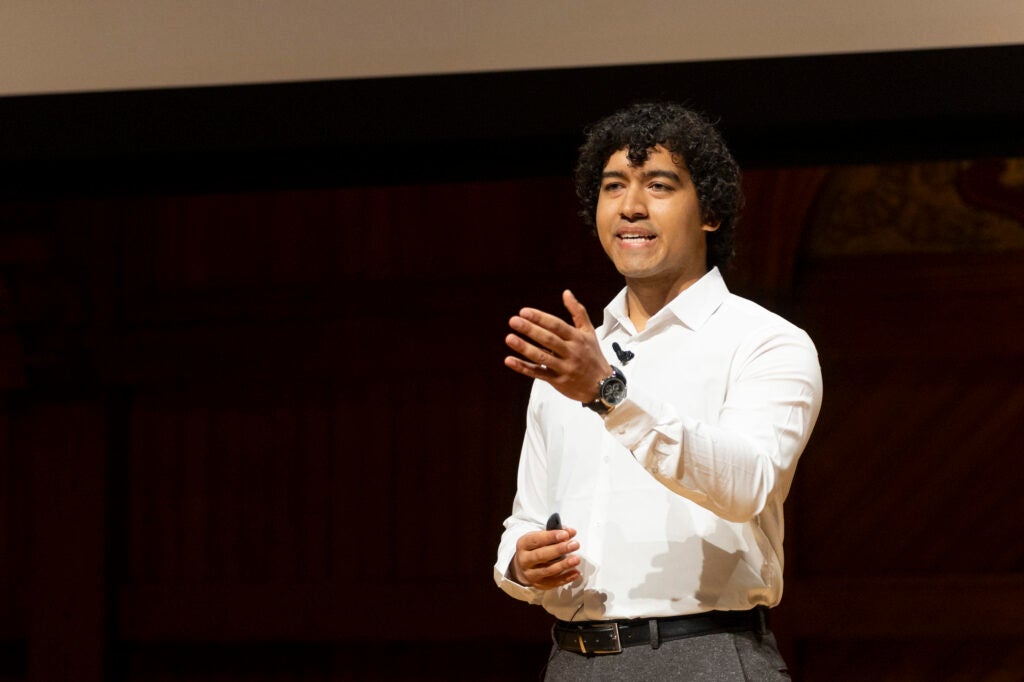
Harvard University
Dylan Renaud
Applied Physics
“Data is all around us, and we just can’t seem to get enough of it,” Renaud said. But handling and storing the massive amounts of data produced today requires enormous amounts of energy. And it isn’t slowing down: Up to 24 percent of global energy consumption could be dedicated to storing data by 2030. Renaud has identified one area that could increase efficiency — updating conventional modulators. In his research, he created a technology called thin-film lithium niobate modulators. These devices — which contain features as much as 100 times smaller than the thickness of human hair — resulted in a 20 percent reduction in energy. With further research and development, they could go even further. “While [there are] big challenges, I think these tiny devices are up for the task,” he said.

Noah Toyonaga
Physics
“Geometry for me is a way of seeing, is a way of appreciating, understanding, and playing,” Toyonaga said. And in the last few years, he’s been playing around with the geometry of scissors. This shape — created by two straight pieces with a pivot between them — appears in biology, textiles, and architecture. Through a method he calls amigami, he created a lattice of scissors that could be used to solve a host of design problems. Showing the audience the shape, which he referred to as the “big donut,” he explained that it’s just one example of how playing with geometry could result in new discoveries. “There’s nothing magical about scissors,” he said. “[Many shapes] could be similarly unpacked to reveal a host of beautiful, unexpected phenomena.”
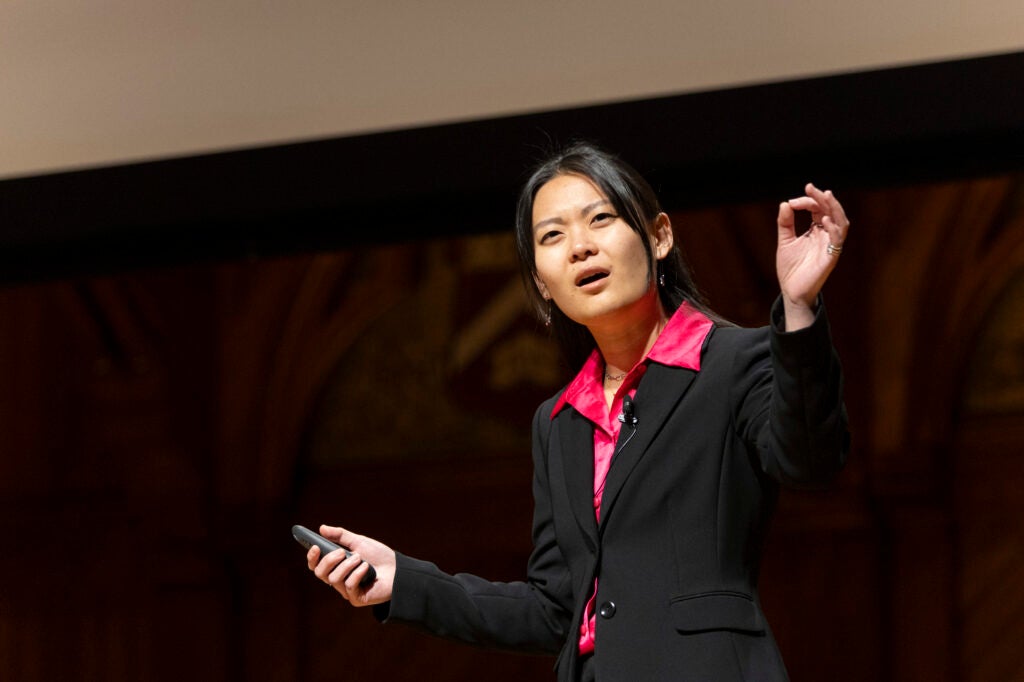
Harvard University
Jiemin Tina Wei
History of Science
“To the average American office worker, modern wellness can feel exhausting,” Wei said, showing a variety of recently published self-help and wellness books on screen. Her work focuses on learning how we became a society fixated on addressing work fatigue and burnout. Experts began wrestling with labor shortages during the rapid industrialization of the early 1900s. Researchers pitched solutions ranging from ways to address physical fatigue to improved ergonomics to suggesting the problem was all in the mind. Some of this research has led to what we see in high-stress, 24/7 work environments like those in Silicon Valley, with the blurring of work-life boundaries and the creation of a culture in which workers simply work harder and longer. She said that in some ways, companies learned that if you can harness the minds of workers, you can “make labor work for you.”




